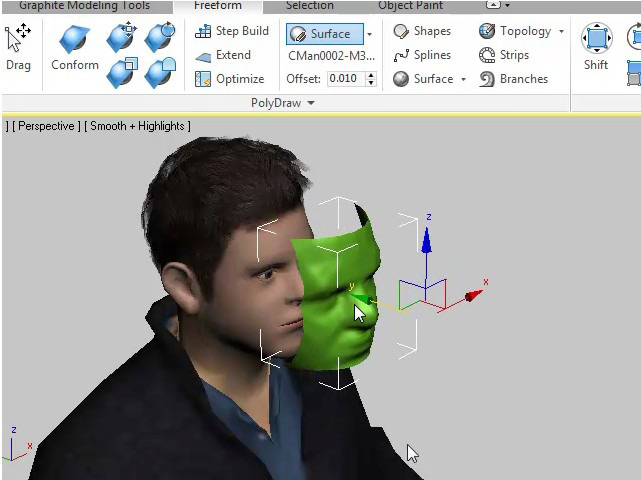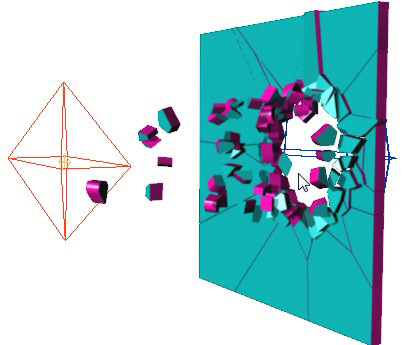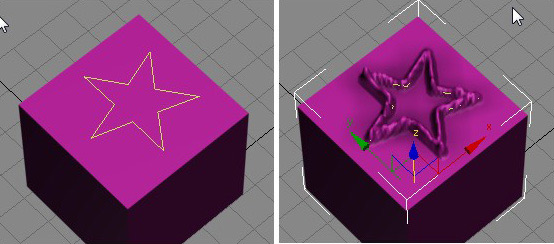 Software Review:
Software Review:
3ds Max Entertainment Creation Suite Premium 2012
Publisher: Autodesk
Type: 3D Software Package
Cost:
Full: $6,495.
Upgrade: $2,995.
Student price: Free 3 year license at http://students.autodesk.com
Subscription: $1,300 (subscription with Gold support)
Included Software: Autodesk Entertainment Creation Suite for Entertainment containing Autodesk 3ds Max, Autodesk Maya, Autodesk Softimage, Autodesk MotionBuilder, Autodesk Mudbox and Autodesk SketchBook Designer)
Release Date: Available Now
Official Website: http://www.autodesk.com
Download Demo: Click Here
Samples: n/a
Review Issue: Issue #71 (November 2011)
Reviewed By: Michael J. Muwanguzi
Final Score: 8.6 out of 10
For the past several years, programs like 3ds Max, Softimage, Mudbox, and MotionBuilder were separate, unique experiences all on their own. Artists, as well as companies, had to ally themselves with one particular 3D application to supply most of their needs and be cautious when considering any other packages to add on that might throw a wrench in their existing pipeline. Since those days, Autodesk has been working to bring the biggest 3D applications used in the entertainment industry under one roof. But collecting all the most popular tools was not all Autodesk had plans to do.
In the 3ds Max Entertainment Creation Suite 2012, Autodesk continues to help bridge the gap between using these distinct programs into a more seamless experience. Single-step interoperability has become smoother and more powerful in passing assets between each program. Artists can leverage exclusive tools for that particular software on their project, save it, and find it updated upon returning to its application of origin. The controls for working with fCurves for animation have been made consistent throughout all the programs that have an animation editor so that artists will not have to waste mental energy getting reacclimated to a new environment. And implementing new features across the board, like Vector Displacement Map support, helps to save time for people wanting to use a particular feature without having to constantly resort to jumping to another program to utilize it.
 |
The new Character and Characterization Toolset help riggers setup consistent rigs for character models for animation and error reporting. |
Ease of Use
The 3ds Max Entertainment Creation Suite Premium contains 4 fully individual programs with their own distinct workflows. For people that are already familiar with some or all of these programs, the extra features will not be too hard to grasp. But for those that are unfamiliar with each of these programs methods, it will take a while to get used to them. That being said, checking out our previous reviews on 3ds Max, Softimage, and Mudbox would be a good introduction to learning the strengths of each program. The rest of the review will be dedicated to the new options available when using these 3D applications in conjunction with each other.
 |
The conform brush is an efficient way to transfer to topography from one surface to another. |
New Features
Technically, I’m breaking our normal formatting by listing the New Features outside of Depth of Options, but it seemed unfair to not make the two distinct in this situation.
3ds Max
Substance Smart Textures is a new way of procedurally modifying common textures found in the world. These 2D textures that are dynamically created are resolution-independent (folks who use vector based vs. pixel based tools know how powerful resolution independence can be). Despite the fact they are procedurally created, they take up small amounts of memory to produce amazing, quality textures. Most parameters are editable and animate-able with the option of baking them into bitmaps for the final results before exporting. Tweaking parameters like distribution, surface aging, color variation, density, and other specific features for the variety of textures available help to make each surface look unique and credible.
Part of the new MassFX unified system of simulation solvers, Rigid Body dynamics is a new physics module that makes use of the NVIDIA® PhysX® engine. MassFX supports static, dynamic, and kinematic rigid bodies that can be simulated right in the 3ds Max viewport. Constraints such as Rigid, Slide, Hinge, Twist, Universal, Ball & Socket, and Gear can also be applied to the rigid body parameters. Physical properties like friction, density, and bounciness can be applied through presets or tweaking their settings. Whether you are building an animated special effect or leveraging the power of simulation to model interesting features into your creations, MassFX can be utilized to bring real world interaction to a production.
An initiative that Autodesk is taking with all their animation software in the Entertainment Suite line is having a common F-curve Editor in every program that has animation. This is great for artists that take advantage of moving a project back and forth, and not having to conform to the idiosyncrasies of each packages animation workflow. The curve editor also offers better in-context curve controls, multi-point editing, and toggling of the Controller Window. The inclusion of the new Region Tool, Tangent Actions toolbar, and refined interface make to increase the efficiency of animating in 3ds Max
The UVW Unwrapping Modifier is a means by which artists can assign and edit the texture coordinates of a mesh. Improvements to the Unwrap UVW include a streamlined interface, new toolbars and rollouts to replace going through menus, Peel toolset method of unwrapping texture coordinates, and new tools for editing the texture coordinates. This overhaul makes using the UVW modifier more efficient for artists to prepare their models for texturing.
Softimage
ICE Modeling is a new way within Softimage 2012 to procedurally create and alter a polygon mesh. Multiple instances can be generated to have slight variation, objects can be shattered through animated simulation, and special effects can be created by building custom compounds. Polygons built through ICE Modeling can have the faces, edges, and vertices transformed, have materials, texture projections and user normals applied, and are able to have operations like cloning, repeating, and merging applied to the topography. Being able to model by taking advantage of simulation is a far more efficient way to achieve the randomness found in the real world.
Syflex ICE is the evolution of the Syflex Cloth plugin, previously available in Softimage. With Syflex ICE, a complete set of deformation simulators, force, constraint, and collision compounds can be utilized for cloth and curve deformation simulations. On top of that, most common ICE nodes can be used in conjunction with the network to empower artists to make greater effects. Syflex ICE loads faster, solves more complex meshes, and has unique methods for solving a simulation than the original Syflex Cloth plugin did.
Mudbox
With the emergence of the PTEX technology of texturing, programs that take advantage of this new method of painting their models gain the benefit of working without having to establish UVs at the onset. PTEX can handle single meshes to models with multiple meshes. Paint layers can also be exported to PTEX files individually. For added control later on in your 3D application of choice, ambient occlusion maps, vector displacement maps, displacement maps, and normal maps can be extracted and exported as PTEX files, too. Once the textures have been created they can be exported and baked in UV space after UVs have been prepared.
“Layers” within Mudbox has had its abilities extended with the inclusion of layer masks and blend modes. Layer masks are a nondestructive way of hiding and showing certain parts of a texture applied to a layer. Textures can be blended together artistically with 22 new blending modes (making a total of 27 in all that are now possible). All blending modes are compatible with Adobe Photoshop CS5, making it easy to transition texture files without having to do clean up after conversion.
Stencils can be created and edited within Mudbox. Using Sculpting tools like Grab and Pinch, stencil shapes can be transformed from the original image. All of the painting tools can be used to make alterations on original or new stencils. After they have been made, they can be used and discarded or saved for later use.
MotionBuilder
One program that benefits the most from a consistent fCurve editor is MotionBuilder. The functionality for multi-point editing has had visual enhancement for better usability. Keyframes can be marquee selected and scaled as a group. They can be stretched out, in, or negatively to fit the animators need. Isolated curves help animators focus on just the curves that need immediate attention. The auto-tangent type is a revised way of handling the refinement of transitions between keyframes. To finish off the list of changes to the fCurve Editor, a more simplified toolbar may be preferable to maximize screen real estate, but also giving users the choice to switch back to the heavier Classic Mode.
Two new character setup tools that have become standardized in Autodesk’s 3D animation packages have also been added to MotionBuilder. The new Character Controls interface is a visual means of modifying the IK and FK controls for a mesh’s rig. Different parts of the rig can be activated or locked all the while giving feedback as to the values that are being keyed into the rig controls. Pinning, auxiliary effectors and pivots can be adjusted between the Control rig and the original source. The other Character setup tool is the Characterization Tool. From this interface, riggers can map and define the structure of characters for error reporting later.
 |
ICE Modeling lets artist create objects based off of a simulation that would take longer trying to make the assets by hand. |
Depth of Options
3ds Max
The Slate Material Editor uses a nodal-based system to create a material network visually rather than through scripting. Improvements to Slate include using the keyboard to navigate quickly through the browser window and having Slate operations under the influence of undo and redo commands to correct mistakes in the editor. Inputs within the editor such as materials, map, controller nodes, spinners, and numeric field conform to the same interaction found throughout the 3ds Max environment. Ctrl and Alt commands that are characteristic in other menus can be done within Slate as well. Rounding out the changes is the inclusion of a variety of operations that before were only accessible through the Compact Material Editor.
The Caddy Interface is an in-canvas contextual interface that contains a dynamic label and buttons within the viewport. The improvements to the caddy include better positioning in relation to the affected area, more keyboard shortcuts, and default behavior that doesn’t block the view of the selected region.
The Graphite Modeling tools have been extended to provide some new ways of painting and sculpting models. The Conform Brush allows artists to imprint a physical likeness of one mesh onto another. This is a much faster way of transferring a mesh into another without duplicating it and stitching it into new geometry by hand. The Shift Brush that allows artists to pull a group of vertices within a brushes range and falloff now has rotate and scale variants. The Constrain to Spline option lets artists limit the movement of an selected region solely to the form of a shape or a spline. This technique is a fast and easy way to emboss an intricate curve design on any type of polygon surface.
Before exporting or rendering a model for final output, it may be necessary to make it more lightweight for purposes of computation. The ProOptimizer Modifier iterates over a mesh and lowers the density of the amount of polygons used with little or no change from the final output of the original mesh. The update to the ProOptimizer now offers improved optimization, almost zero face-flipping, and polygons having uniform dimensions across the mesh. UV and Normal interpolation have been improved to offer smoother transitions. Lastly, vertex position can be locked to reduce distortion in meshes that have already been optimized.
Softimage
To improve the user experience, the schematic view has been updated to better support the Maya interactive mode by adjusting a few commands that were in conflict with the workflow. Labels in specifying fcurves, expressions, and linked parameters concerning animation can be displayed. The Sc and Scop labels also specify their respective components as well for quick visual reference. Brushes can have a radius below .01 for better manipulation of dense meshes. The Weight Editor now allows the numerical adjustment of weight maps and vertex color, displays the property and object name that is being edited, autofit display names, and updates the view of the currently locked selection. Lastly, when Click Outside Manipulator is set to either Simple Transform or No Interaction, the user can right-click anywhere to display a contextual menu.
Lagoa Multiphysics is an ICE simulator that creates advanced fluid, soft body, rigid body, and cloth effects. Its framework provides a single unified environment to build different physical effects. Lagoa effects can be built from a list of presets or from scratch. Once part of the ICE tree, other ICE commands, nodes and presets are available for use in conjunction with Lagoa.
Mudbox
Hot box has made its way into Mudbox. Taking the idea from Maya’s own hot box, Mudbox’s unique hot box offers the same method of quickly bringing up an interface to perform an operation or use a tool without having to go up to the menubar. Once the position of the contextual marking menus and favorite tools have been memorized, artists can instinctually grab what they need, greatly increasing their workflow.
Brushes in Mudbox have a few new additions that make them more versatile across the board. A single brushstroke can now affect multiple objects. Grab Silhouette and Follow Path are new Grab-type brushes that move the front and back of a mesh simultaneously and make the polygons follow the path of your stroke, respectively. Falloff has the new Falloff based on Facing Angle option that lessens the effect of a paint or sculpting stroke based on how perpendicular the angle of the face is to the camera.
Posing in Mudbox has become even easier with the induction of multiple joints and pose presets. The updated Pose Tools let artists create and weight multiple joints for full figure poses. Auto-hierarchies create joint hierarchies based on proximity to surrounding vertices. Symmetrical joint pairs and imported skeletons are also supported. Finally, pose presets let you save and store poses that affect the same joint hierarchy
MotionBuilder
For animation heavy scenes, MotionBuilder supports storing and playback of point cache data on models to boost performance. Recorded animation can be transferred based on complex constraints or physics set-ups too. PhysX point cache recording is also available to softbodies and cloth. And if there is any slow down in playback of physics simulations, enabling ForceAnimationSync uses a new physics solver to focus on rendering just the physics for better playback.
Stereo camera support, based on the Maya/Flame stereo camera rig, is now part of MotionBuilder. Taking the three dimensional renders, it creates depth of field through the calculation of the Stereo camera attributes. These parallel images can then be taken and composited in another program.
 |
Constrain to Spline is a great way to make embossed decals on surfaces. |
Performance
3ds Max
A huge new feature that has a lot to do with the improved performance in 3ds Max 2012 is the use of the Nitrous accelerated graphics core. Leveraging today’s GPUs and muti-core, multi-threaded computers, Nitrous powers a new viewport system that enables artists to iterate quickly without having to put up with lag as the process tries to update the window. Each viewport can be configured separately as well as by making configurations in the Visual Style & Appearance panel. This render-quality display environment supports performance-pushing features like unlimited lights, soft shadows, and high-quality transparency, to name a few. Artists can render with realistic results or enhance their work by experimenting with stylized rendering like ink, acrylic, graphite, etc. To make full use of all the capabilities, Nitrous does require a Direct3D card with at least 1Gb of dedicated memory.
The iray renderer® from mental images® produces stunning photorealistic scenes with a lot less hassle setting up the renderer. iray uses a physically-based rendering method and combines following light paths with progressive rendering (improving quality over time). Artists can set the amount of time they want to render, decide how many computational iterations it should loop through, or simply let it render indefinitely with the user having the final say of when it is finished. As it processes the image, the quality of the render transforms from grainy to crisp and clear. Of particular note is iray’s ability to produce believable reflections, which include glossy, and self-illuminating objects. iray is an amazing solution for artists that want to quickly and accurately see the final results.
Softimage
In order to have higher fidelity for the simulation render, ICE Subframe Sampling controls how many times a frame is sampled more than once for a more accurate result. Situations that would call for this kind of action would be simulations with emitted particles that move very quickly, emitted from a deforming object, collisions and objects with constantly shifting positions, and particularly small particles that need more precise collisions. By increasing the subframe samples, the simulation has more accurate results.
Mudbox
The performance improvements within Mudbox affect general operations used commonly in the software. Painting and sculpting higher resolution maps are process more smoothly. Scenes that contain textures save in less time. The creation, selection, and duplication of paint layers are more interactive. Finally, OBJ meshes that are really dense load faster.
Another fortunate repercussion of the overall performance improvement within Mudbox is its ability to handle larger texture datasets. Higher texture capacity translates to higher quality assets that are limited only by the memory and processor constraints of the user’s computer.
MotionBuilder
In order to assist in finding problem areas in rendering a particular scene, the Profiling Center lets users monitor scene performance and see where leakages are taking place. Selecting Frustum Culling restricts rendering to only what is in the viewport. Evaluation controls what task order will be undertaken, either consecutively, by model hierarchy, and whether or not they have dependencies. Last, but not least, on the list is Profiling Display which gives options for what performance information is going to be displayed while the render is processing.
Value
The 3ds Max Entertainment Creation Suite Premium has the benefit of having mostly industry-standard software as part of its package and not a bunch of filler. Each program has a clear purpose of intent and has been used by the entertainment industry for some time now. And when you consider that just a few short years ago, one of these programs would have cost the same amount as the whole suite, it’s fair to say that the pricing, though a lot, is heading in the right direction for the consumer. This suite covers pretty much all your 3D creative needs with a little left over, and for the ones who can afford it, they will not need to add anything else or upgrade for some time.
 |
The new Nitrous accelerated graphics core makes it possible to use stylizing effects on the viewport like these. |
Final Comments
The Entertainment Suite initiative is exciting because it is trying to give the most popular programs a common ground to work off of each other without going in the direction of software homogenization. By keeping the programs separate, like in the case of 3ds Max and Softimage, an artist can stick with what they are most comfortable with, but still be able to sneak over to the other side and make use of what makes other programs so great as well. Newer programs like MotionBuilder and Mudbox can be introduced to new artists that may not have had the chance to see what advantages they possess, as well. This suite may be too much for the hobbyist to play around with, though, as there’s just too much learn and understand here. But for the creative professional, or the one headed in that direction, this software suite will be more then sufficient to create the most sophisticated imagery and animation seen today.
BREAKDOWN7.0 : Ease of Use
|

4 Comments
Hi,
I would like to know, if there´s available the human ik for 3dsmax 2012. I animate a character in motionbuilder 2012, then I have send it to maya 2012 and works pretty well. But after that, I tried to send my animated character from motionbuilder 2012 to 3dsmax 2012 and in max, the character is looking well, but I can´t modify the animation. Do you know, where is the character control and characterization tool window in 3dsmax 2012?
Thanks in advance 🙂
-Amaia
I’ll see if we can find that out from the author! Good question!
Hey Amaia,
I apologize for not getting back with you sooner. I tried to do some research into where the animation data gets transferred into when you get to 3DS Max.
The only thing I came across that works with animation is CAT (Character Animation Toolkit) and Character Studio; the latter sounding like the more suitable choice for controlling animation. Also, I believe exporting in the .fbx format will help retain the animation data if it did not import in correctly into 3ds Max. I am not as familiar with 3DS Max as I am with Maya, so I couldn’t give you a definite solution to trying to access your animation from Motionbuilder.
The specific character control and characterization tools are proprietary to Maya, and I’m not sure if it is a feature that they are going to make available across all software packages.
Not much help, but I hope that it gets you going in the right direction.
Michael Muwanguzi
i should very much like to rent a beach hut at saltdean. as a keen �p88;2rawnerࢭ on the local rocks a hut would be very useful. however, in the current economic climate i should imagine that airborne swine are more likely to be seen in saltdean than new beach huts !tony stuart